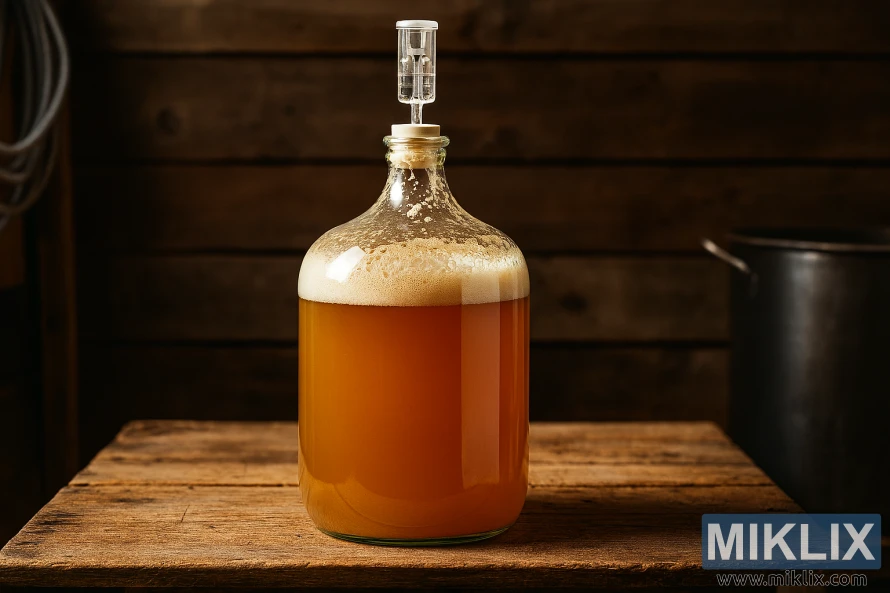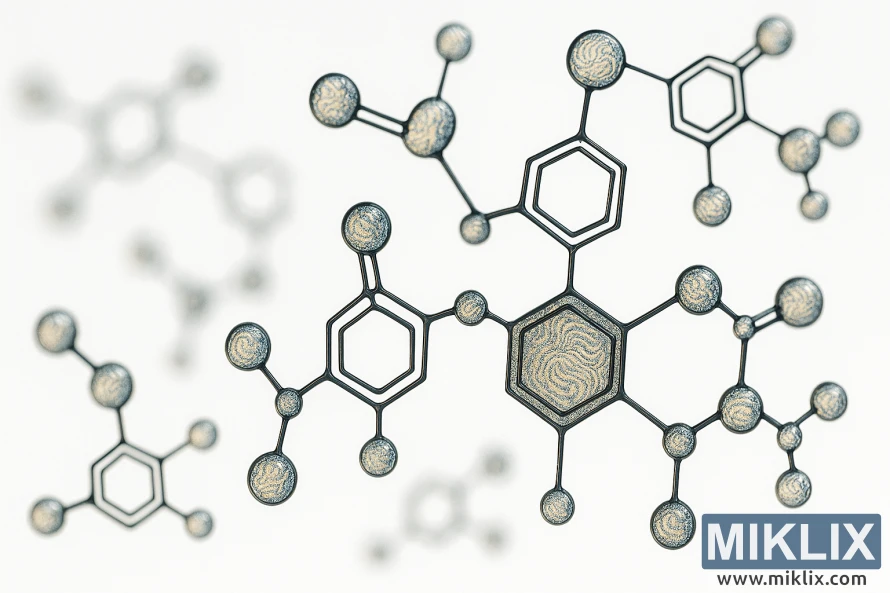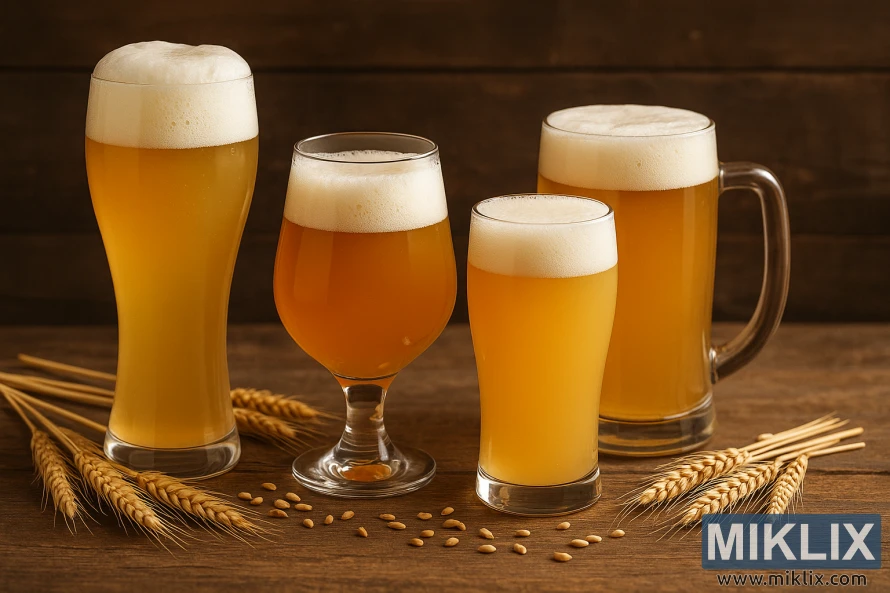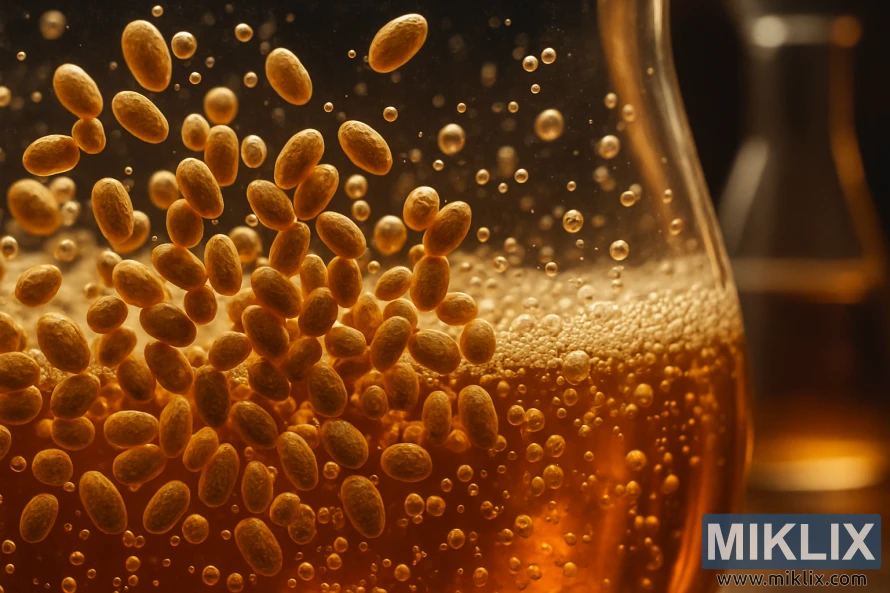Fermenting Beer with Fermentis SafAle WB-06 Yeast
Published: August 14, 2025 at 6:48:22 AM UTC
Last updated: November 27, 2025 at 3:29:08 PM UTC
Fermentis SafAle WB-06 Yeast is a dry brewer's yeast, perfect for wheat beers like German Weizen and Belgian Witbier. This strain, Saccharomyces cerevisiae var. diastaticus, offers a blend of fruity esters and subtle phenolics. It's favored for crafting bright, refreshing wheat beers with a smooth mouthfeel and excellent suspension during fermentation.

Many hobbyists praise WB-06 for its high apparent attenuation, thanks to diastaticus enzymes. These enzymes can reduce body and increase alcohol content. Fermentation might take longer, so patience is key to avoid overcarbonation in bottles. It's available in various sizes, from 11.5 g sachets to 10 kg formats. The product also includes yeast and emulsifier E491, certified for professional use.
When purchasing dry brewer's yeast, it's important to check lot dates and storage recommendations to ensure viability. With proper pitch rates and temperature control, this yeast can produce either a classic Hefeweizen or a clean Witbier, depending on your recipe.
Key Takeaways
- SafAle WB-06 is a dry brewer's yeast designed for wheat beers and experimental uses.
- The strain is Saccharomyces cerevisiae var. diastaticus and can increase apparent attenuation.
- Expect fruity and phenolic character influenced by fermentation conditions.
- Available in multiple pack sizes; E2U certified and contains emulsifier E491.
- Purchase from reputable suppliers with secure payment methods and check viability dates.
Why Choose Fermentis SafAle WB-06 Yeast for Wheat Beers
Fermentis SafAle WB-06 is crafted for wheat-based beers, celebrated for its clear fruity esters and clove-like phenolics. It's a top choice for Hefeweizen, Witbier, and Roggenbier due to its reliable character and versatility in modern wheat recipes.
This yeast strain boasts medium esters and apparent attenuation between 86–90%. Its drier finish is a standout compared to many wheat yeasts. The diastaticus activity enhances its ability to break down complex sugars, boosting attenuation and drinkability for summer brews.
WB-06 wheat beer benefits include strong suspension during fermentation, which enhances kinetics and contributes to a rounded mouthfeel. Brewers can control temperatures to balance banana-like esters and clove phenolics, tailoring aroma and flavor to their style preferences.
- High attenuation for a drier, more drinkable finish
- Notable phenolic and fruity character adaptable by process control
- Good flocculation behavior that supports steady fermentation kinetics
Opt for WB-06 when seeking elevated attenuation and a yeast that accommodates varied wheat grists and recipe adjustments. The blend of WB-06's benefits and SafAle's characteristics makes it an excellent choice for both traditional and modern wheat beers.
Understanding Apparent Attenuation and Fermentation Performance
Fermentis SafAle WB-06 exhibits an apparent attenuation range of 86-90%. This indicates a high sugar conversion rate, leading to a dry finish. The specified attenuation range is key to understanding why final gravities often drop below those of standard ale strains.
The yeast's diastaticus-like activity allows it to break down dextrins and complex sugars. It uses extracellular enzymes such as amyloglucosidase for this purpose. This capability boosts fermentation performance but can prolong active fermentation in cooler or low-nutrient worts.
When working with WB-06, practical planning is essential. Expect a drier beer and avoid rigid timelines. It's important to monitor gravity to terminal, not just by days, to avoid over-carbonation during bottle conditioning.
Key steps to manage higher attenuation:
- Track specific gravity until two consecutive readings match.
- Allow longer conditioning in keg or bottle to stabilize residual sugars.
- Consider slightly higher mash temperatures to retain dextrins when a fuller body is desired.
Understanding the balance between apparent attenuation WB-06 and fermentation performance is critical. It helps brewers control mouthfeel, alcohol level, and carbonation risk. Adjust schedules and recipes to align with the yeast's tendency for thorough sugar attenuation.
Packaging, Viability, and Shelf Life of SafAle WB-06
Fermentis offers SafAle WB-06 in various sizes: 11.5 g, 100 g, 500 g, and 10 kg. Small sachets are ideal for single batches, while larger bricks cater to frequent brewers and microbreweries. Select a pack that aligns with your brewing frequency to prevent waste and ensure quality.
The dry yeast from Fermentis boasts a high viable count, exceeding 1.0 × 10^10 cfu/g. This high viability supports reliable fermentation, even when pitching without full rehydration. With purity above 99.9%, it minimizes contamination risk and simplifies handling for both home and small-scale brewers.
Each sachet has a 36-month shelf life printed as a best before date. For storage up to six months, keep packs below 24°C. For longer storage, reduce the temperature to under 15°C to maintain cell health and extend the shelf life to 36 months.
After opening, sachets must be resealed and refrigerated at 4°C. They should be used within seven days. Avoid using soft or damaged sachets. Adhering to these storage conditions ensures the yeast's high viability and readiness for consistent pitching.
- Choose the WB-06 packaging sizes that match your usage to avoid long-term open storage.
- Store unopened packs under recommended storage conditions to retain viable counts.
- Once opened, reseal and refrigerate; use within seven days for best results.
Fermentis highlights that dry yeasts like WB-06 are tolerant of various handling scenarios. They can handle cold or no rehydration without compromising fermentation kinetics or analytical profile. This robustness benefits brewers working in diverse conditions, ensuring consistent performance and viability cfu/g.
Pitching Options: Direct Pitching vs. Rehydration
Fermentis endorses two distinct methods for SafAle WB-06. Direct pitching involves sprinkling the dry yeast onto the wort's surface at or above the desired fermentation temperature. This should be done during the initial filling to allow the wort temperature to stabilize and the yeast to distribute evenly. It's essential to follow the label instructions to ensure the yeast covers the wort surface, preventing clumping.
On the other hand, rehydration requires sprinkling the yeast into at least ten times its weight of sterile water or boiled and cooled hopped wort. This mixture should be held at 25–29°C (77–84°F) for 15–30 minutes. Afterward, gently stir to create a uniform cream, then add it to the fermenter. This method aids in cell revival, which is beneficial for sensitive or larger batches.
Studies by Lesaffre and Fermentis reveal that dry yeasts can tolerate cold or no rehydration without significant loss of viability. This flexibility allows brewers to choose the pitching method based on their specific needs. For quick, low-effort brews, direct pitching is ideal. For critical fermentations or when aiming for maximum cell revival, rehydration is the preferred choice.
Practical tips for direct pitching include maintaining wort oxygenation and avoiding clumps by sprinkling slowly. For rehydration, use clean vessels and adhere to temperature guidelines to prevent shock. Both methods are effective with SafAle WB-06 when executed correctly.
The decision on how to pitch WB-06 hinges on batch size, risk tolerance, and schedule. Small homebrew batches often benefit from direct pitching for its speed. In contrast, commercial or competition beers may require rehydration for consistent results and smoother fermentation starts.
Recommended Dosage and Fermentation Temperature Range
Fermentis suggests using 50-80 g/hl of WB-06 for the best outcomes. This translates to 1.9–3 g per US gallon for homebrewers. For fruitier esters, use the lower end. For tighter ester production and more phenolic notes, opt for the higher end.
For reliable performance, maintain the WB-06 fermentation temperature between 64-79°F. The manufacturer's ideal range is 18–26°C. Aim for consistent temperature control to ensure predictable attenuation and flavor balance.
Practical choices are key. A 50 g/hl pitch at the cooler end of the WB-06 fermentation temp enhances banana and clove flavors, ideal for many Hefeweizen recipes. Increasing the pitch to 80 g/hl and warming the temperature brings out more phenolic clove and spiciness, typical in traditional wheat and rye beers.
- Use 50-80 g/hl as your baseline.
- Target 64-79°F for ferment temperature control.
- Lower pitching + lower temps = more esters.
- Higher pitching + warmer temps = more phenolics.
Keep a record of your experiments and make adjustments in small increments. Consistent WB-06 dosage and steady WB-06 fermentation temperature are essential for achieving repeatable results in brewing classic wheat styles.
Controlling Ester and Phenolic Profiles Through Brewing Choices
Fermentis SafAle WB-06 empowers brewers to craft distinct flavors. The interaction between pitching rate and fermentation temperature is key. It allows for the manipulation of esters and phenolics, aligning with specific beer styles.
Lower pitching rates, around 50 g/hL, often boost ester formation. With WB-06, this leads to the production of isoamyl acetate and other fruity compounds. These compounds contribute to the banana notes in the beer. When combined with cooler temperatures, the yeast's fruity profile is enhanced.
Conversely, higher pitching rates, near 80 g/hL, tend to reduce ester production. At these levels, the yeast focuses more on phenolic expression, resulting in clove and spice notes. Elevating the fermentation temperature to 22–26°C further accentuates this effect, tilting the banana-clove balance towards clove.
Utilize these variables as a guide, not a strict formula. Style-specific guidance is essential:
- For a fruit-forward Hefeweizen: low pitch + cooler ferment for a pronounced banana character.
- For a spicier Roggenbier: higher pitch + warmer ferment to favor clove phenolics.
Recipe composition significantly influences the outcome. The percentage of wheat, malt kilning, and ferulic acid precursors all impact phenolic conversion. Water profile and hop additions also play a role in shaping the perception of esters and phenolics.
For consistent results, follow these steps:
- Determine your desired banana-clove balance and set initial pitching rate and temperature.
- Keep other fermentation variables consistent to isolate yeast response.
- Record outcomes and adjust malt bill or mash steps as needed to fine-tune ferulic precursors.
These strategies enable brewers to fine-tune flavors with WB-06. View these guidelines as a starting point. Conduct controlled trials to align the beer with your recipe goals, managing esters and phenolics through simple fermentation adjustments.

Practical Fermentation Timelines and Kinetics with WB-06
Fermentis lab trials monitored alcohol production, residual sugars, flocculation, and kinetics for SafAle WB-06. Brewers should adhere to Fermentis guidelines and conduct small-scale tests before scaling up.
WB-06 fermentation time can fluctuate based on wort composition, oxygenation, and pitching rate. Expect an initial active phase within the first 48–72 hours. Then, a slower attenuation period ensues as the yeast processes more complex carbohydrates.
WB-06 exhibits amylolytic activity, potentially necessitating extended fermentation to achieve terminal gravity. Fermentis notes that, under specific conditions, the yeast may require over 10 days to complete fermentation.
Regularly monitoring gravity is more reliable than relying on calendar days. Measure specific gravity at least twice, 48 hours apart, to confirm stability before transfers or packaging.
- Plan for an initial vigorous phase, then a two-stage decline in fermentation rate.
- Allow for extended fermentation when using high adjunct or high-dextrin malts.
- Use temperature control to keep kinetics steady; small rises can speed activity, drops slow it.
Patience is key to avoiding off-flavors and bottle bombs. Bottling should only occur once residual diastaticus activity has ceased. Ensure gravity stabilizes at the expected final reading before conditioning or carbonation.
For practical planning, standard WB-06 batches typically require 7–14 days. Adjustments should be made for larger volumes, cooler fermentations, or recipes with increased complex sugars.
In cases of uncertainty, consider running a parallel trial ferment. Controlled tests can unveil the actual kinetics of your recipe. This helps establish realistic timelines for future brews, using WB-06 fermentation time as a benchmark.
Strain Safety, Microbiological Purity, and Regulatory Notes
Fermentis SafAle WB-06 arrives with microbiological specs that brewers can verify before use. It guarantees a viable yeast count above 1.0 × 10^10 cfu/g. This ensures consistent pitching rates and clean fermentation starts, with purity exceeding 99.9%.
Testing adheres to EBC Analytica 4.2.6 and ASBC Microbiological Control-5D standards. Acceptable limits include lactic and acetic acid bacteria, Pediococcus, and wild yeast at less than 1 cfu per 10^7 yeast cells. Total bacteria limits are under 5 cfu per 10^7 yeast cells. This provides a clear framework for microbiological specs and traceability.
WB-06 is Saccharomyces cerevisiae var. diastaticus, known for its extracellular glucoamylase activity. This enzyme profile enhances higher attenuation, beneficial for wheat and saison styles. Brewers must weigh the benefits against the risk of cross-contamination in mixed-brewery operations.
Implementing containment and labeling is essential for protecting other production lines. Use dedicated equipment or strict segregation when fermenting beers with diastaticus strains. Cleaning routines and validated sanitizers help minimize the risk of stray cells on surfaces.
Regulatory compliance demands control of pathogenic micro-organisms and adherence to local food safety rules. Maintain batch records, certificate of analysis data, and microbiological test results. These documents demonstrate due diligence for safety and quality.
Document storage and handling practices, including the guaranteed viable count in cfu/g and WB-06 purity figures. Clear records help quality teams confirm yeast meets specifications. They also ensure that corrective actions are traceable if a deviation occurs.
Recipe Guidance for Classic Styles: Hefeweizen, Witbier, and Roggenbier
Begin by aligning pitching rate and temperature with the style. For a Bavarian Hefeweizen, opt for a lower pitch and ferment near 70°F (21°C). This approach ensures a balanced mix of banana and clove flavors, complementing the high wheat content in a WB-06 hefeweizen recipe.
When crafting a Belgian-style wit, increase the pitching rate and ferment slightly warmer to enhance clove notes. Incorporate traditional spices like coriander and Curaçao orange peel in your WB-06 witbier. This allows the spiciness to emerge through the wheat haze.
Roggenbier benefits from rye's unique peppery and bready notes. Aim for a modest pitch, around 50–60 g/hL, to balance banana esters with rye spice. This method aligns with a practical WB-06 roggenbier plan, where malt choices and mash schedule fine-tune the final flavor.
- Grain bill tips: For hefeweizen, use 50–70% wheat malt; for witbier, include oats or flaked wheat plus 5–10% unmalted wheat; for roggenbier, use 30–50% rye with a pale base malt.
- Mash schedule: Employ a ferulic acid–favoring step near 110–115°F (43–46°C) for more phenolic character in hefe and wit recipes.
- Spices and adjuncts: Add coriander and orange peel late in the boil for WB-06 witbier; keep additions minimal for hefe and roggenbier to showcase yeast-driven aromas.
- Fermentation control: Lower temps and gentle oxygenation favor esters for hefe; warmer, slightly higher pitch favors phenolics for witbier.
Adjust mash pH and water profile to enhance clarity and mouthfeel. Modify protein rest and enzyme management for high-wheat or high-rye bills to avoid stuck mashes and improve head retention.
Keep a record of gravity, temperature, and timeline for each trial. Use these logs to refine your next brew. Small adjustments to pitching rate, mash, or spice timing can significantly impact yeast expression across WB-06 hefeweizen recipe, WB-06 witbier, and WB-06 roggenbier interpretations.

Adapting WB-06 for Specialty Recipes and Additions
When crafting WB-06 specialty beers, align your yeast strategy with the primary adjunct. Fruit, honey, and spices interact with yeast compounds. Adjust the pitching rate and fermentation temperature to highlight the adjunct's aroma and flavor.
For a Honey Weizen, a higher pitching rate is key. It enhances clove and phenolic notes, complementing honey and baking spices. A strong yeast population ensures a clean finish, allowing honey to take center stage.
Raspberry Wheat benefits from a moderate pitching rate and temperatures. This method preserves the fresh raspberry flavor and keeps banana esters in the background. Secondary fermentation helps protect the fruit's volatile aromas.
Dunkelweizen requires adjustments due to dark malts' ability to mask clove phenolics. Increase the pitching rate to about 80 g/hL and ferment near 74°F. This approach boosts phenolic expression and balances malt sweetness with yeast spice.
Here's a quick guide for working with adjuncts and spiced wheat beers:
- Decide which element should dominate: yeast or adjunct.
- Match pitching rate to that goal: higher for phenolics, mid for balance, lower to accentuate subtle fruit aroma.
- Control fermentation temperature to tweak ester vs. phenolic output.
- Add fruit additions later or in secondary to protect aroma compounds.
Small recipe adjustments can significantly impact flavor. Taste-test small pilot batches when trying new adjuncts. This approach minimizes risk and reveals how WB-06 interacts with each ingredient in your specialty beers.
Water, Malt, and Hops Considerations When Using SafAle WB-06
Creating a recipe with SafAle WB-06 requires a detailed plan for water, malt, and hops. Opt for a soft, low-mineral water to preserve the delicate esters and phenolics that WB-06 excels at. Aim for a chloride level that enhances mouthfeel and minimizes harsh bitterness.
The choice of malt is critical in shaping the yeast's aromatic profile. A significant portion of wheat in the malt bill increases ferulic acid precursors, boosting phenolic content. For a traditional hefeweizen flavor, use a mix of 50–70% wheat with pale pilsner or pale ale malt.
- Adding small amounts of Munich or Vienna malts can add bready complexity without overpowering yeast esters.
- Limit dark caramels and roasted malts to keep yeast phenolics in the forefront.
- Flaked wheat can enhance head retention and contribute to a smoother body when using SafAle WB-06.
The mash schedule is key in controlling fermentability and phenolic release. A single infusion mash at 150–152°F (65–67°C) strikes a balance between fermentable sugars and dextrins for a lively yet rounded finish. For increased phenolic presence, consider a step mash with a brief rest at 114–122°F (46–50°C) to elevate precursor levels before saccharification.
When selecting hops for WB-06, focus on varieties with low to moderate alpha acids to complement yeast flavors. Opt for noble hops or softer American aroma hops for late additions or whirlpool use. This approach keeps bitterness in check and highlights the wheat and yeast notes.
- Adjust the sulfate to chloride ratio to influence hop bitterness: lower sulfate for a softer hop profile.
- Use late additions or dry hopping judiciously to avoid overshadowing WB-06's esters and phenolics.
- Match the mash schedule with mash enzymes and grain bill to achieve the desired attenuation for the style.
By carefully balancing malt selection, mash schedule, and hop usage, you can fine-tune the ester and phenolic profiles of your beer. Even small changes in water chemistry and hop timing can significantly impact the final product. Always test these adjustments in small batches before scaling up.
Scaling from Homebrew to Small Commercial Batches
Start scaling by keeping ratios consistent. If you used 50–80 g/hL at home, maintain that dosage when moving up. Confirm cell counts and viability first. Lesaffre’s production methods and viable yeast concentration (>1 × 10^10 cfu/g) support a reliable scale WB-06 transition.
Run pilot batches at brewery size before full production. A 1–2 bbl pilot lets you check pitching scale-up effects on fermentation rate, attenuation, and flavor. Use these trials to adjust oxygenation, temperature control, and nutrient additions.
Choose packaging that matches your needs. For small commercial runs, pack sizes 10 kg give operational convenience and cost efficiency. These packs simplify inventory and reduce frequent reordering for microbreweries.
- Maintain recommended dosages of 50–80 g/hL when increasing batch size.
- Verify cell counts and shelf-life before using commercial fermentation WB-06.
- Keep consistent mash and oxygen routines to reproduce homebrew results at scale.
Control temperature carefully across larger tanks. Fermentis guidance on temperature ranges helps preserve expected ester and phenolic profiles. Cold-tolerant, dry yeast behavior means rehydration is optional, which eases industrial handling.
Sanitation and strain management are critical. When scaling, confirm cleaning regimes to prevent cross-contamination with diastaticus strains. Track fermentation kinetics from pilot runs to full batches to spot deviations early in commercial fermentation WB-06 processes.
Plan logistics for pitching scale-up. Coordinate yeast storage, rehydration supplies when used, and the timing of additions to avoid lag. For 10+ bbl systems, keeping a small propagation step or using fresh packs in pack sizes 10 kg ensures consistent activity and predictable results.
Troubleshooting Common Issues with WB-06 Fermentations
Begin troubleshooting WB-06 by examining sanitation and yeast quality. Practices from Fermentis and lab tests help minimize contamination risks. This reduces the chance of fermentation off-flavors. Keep a close eye on gravity and appearance throughout the process to catch issues early.
Ensure terminal gravity is confirmed with at least two readings 24 hours apart before packaging. Premature bottling can lead to overcarbonation. This is because WB-06 may take time to consume complex sugars.
- If fermentation stalls, first check temperature and pitch rate. Low pitch or cool wort often causes delayed attenuation.
- Gradually increase temperature for a day or two, or perform a diacetyl rest. This can help when the style allows.
- If yeast viability is low, consider repitching active yeast or using a nutrient to revive it.
Review oxygenation and cold-side sanitation if tasting unexpected sulfur, solvent, or sour notes. Contamination on the cold side or poor oxygen control can mimic yeast faults.
- Measure gravity twice before packaging to avoid overcarbonation risk.
- When aromas skew banana or clove, check pitching rate and fermentation temperature. Adjust to tune ester and phenolic balance.
- For persistent stalls tied to delayed attenuation, consider a controlled temperature ramp or fresh, healthy yeast to finish fermentation.
Keep detailed records of temperature, pitch timing, and gravity for each batch. These notes simplify future WB-06 troubleshooting and help reproduce positive results.
When in doubt, isolate variables: change one parameter per batch. This approach reduces guesswork and lowers the chance of repeated issues like fermentation off-flavors or overcarbonation risk.
Laboratory and Producer Insights from Fermentis
Fermentis, a part of Lesaffre production, meticulously develops each yeast strain. They adhere to strict controls to meet the brewing industry's high standards. The company provides a WB-06 technical data sheet. It details key traits such as moderate ester production and high apparent attenuation near the high eighties. It also highlights reliable suspension behavior.
Microbiological testing on these yeasts follows EBC and ASBC methods. Fermentis lab results include viable cell counts, purity checks, and contamination limits. These ensure batches meet standard acceptability before release.
Fermentis conducts controlled fermentation trials using standard worts and set temperatures. They compare strains in these trials. Reports measure alcohol formation, residual sugars, flocculation, and kinetic profiles. Brewers are advised to trial the yeast in their own recipes before scaling up.
Consulting the WB-06 technical data sheet alongside Fermentis lab results is beneficial. Production teams can use this data to predict attenuation, timing, and handling during Lesaffre production runs.
When scaling up from pilot to larger batches, leverage lab reports and seek guidance from Fermentis staff. Their testing and production notes assist in troubleshooting pitching rates, rehydration choices, and fermentation windows. This ensures consistent results.

Conclusion
SafAle WB-06 is a top-notch Saccharomyces cerevisiae var. diastaticus dry yeast, perfect for wheat beers. It boasts an apparent attenuation of 86–90%, with a medium ester character and controllable phenolic expression. Its viability is above 1.0 × 10^10 cfu/g. It comes in various packaging options and has a 36-month shelf life, catering to both hobbyists and microbreweries.
To get the most out of SafAle WB-06, aim for a pitching rate of 50–80 g/hL. Ferment between 18–26°C (64–79°F) to achieve the right balance of esters and phenolics. Regularly check the gravity to prevent over-attenuation from diastaticus activity. You can either pitch directly or rehydrate, depending on your process and sanitation practices.
This summary highlights the quality and handling of SafAle WB-06. It meets industry-standard purity limits and has recommended storage conditions. In the United States, it's available through typical commercial channels. Before scaling up, conduct bench trials and refer to the Fermentis technical sheet. This will ensure it performs well in your recipe and equipment.
Further Reading
If you enjoyed this post, you may also like these suggestions:
- Fermenting Beer with Lallemand LalBrew Wit Yeast
- Fermenting Beer with White Labs WLP095 Burlington Ale Yeast
- Fermenting Beer with CellarScience Hornindal Yeast
